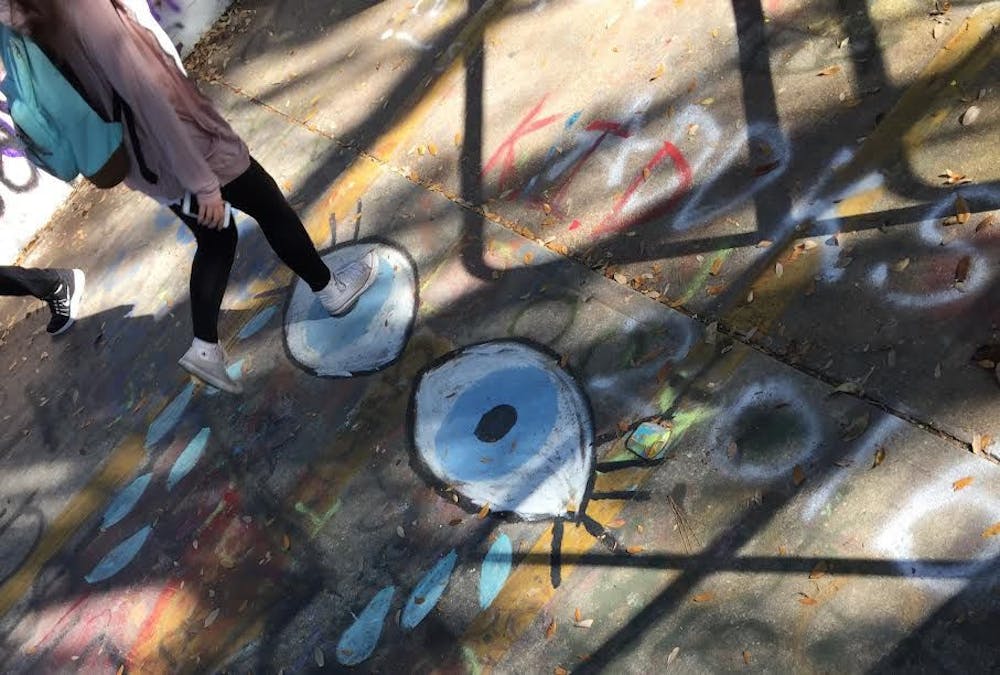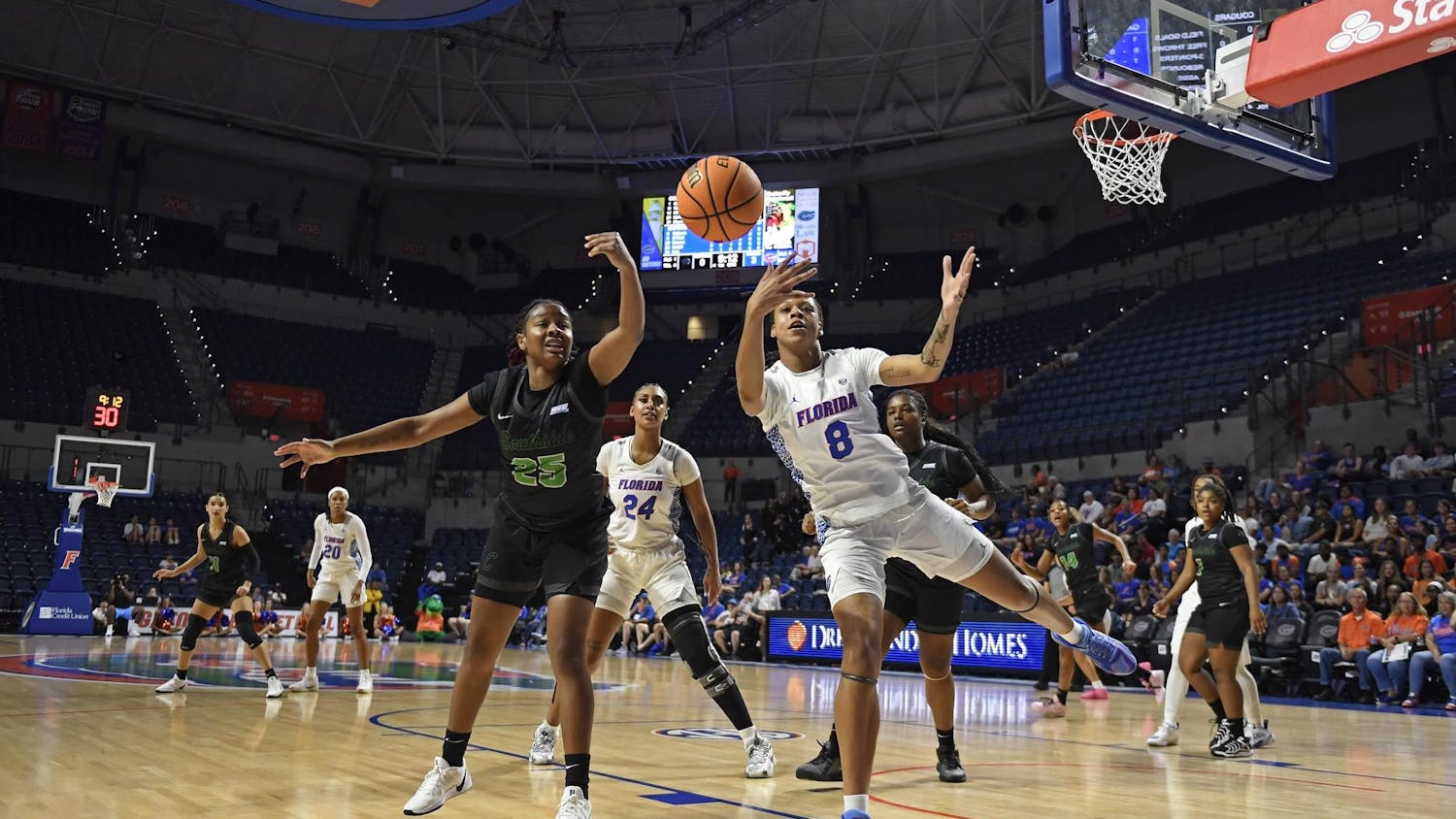To some people, slapping paint on a dirty wall in a shadowy tunnel holds as much significance as hanging a canvas in a pristine gallery, as long as someone sees it.
Emma Magee, a UF public relations junior, put her mark on the walls of Norman Tunnel: a place students know to be full of personal expression and, sometimes, gibberish. Magee, however, did more than just tag the walls. She made a lyric video set to the song “Errors” by K.I.D.
The 20-year-old uploaded her video to her Facebook page Nov. 7 and received almost 1,200 views in less than a day. Magee, a college marketing representative with Sony Music U for the Gainesville area, filmed the video herself. She does a lot of grassroots marketing to promote different events and artists using fliers, posters or murals.
Making the video was mostly about passion for the song, although Magee said she thinks Gainesville would be a good audience for the band.
She said she first heard K.I.D. while at the annual meeting for Sony Music U in New York City, and the experience stuck with her after she left.
“To see an artist that’s, like, so raw that they’re just going to get up there and tell you that they’re going to sing about being sad and that’s OK, I left the trip and could not stop thinking about that moment and that song,” she said.
The song itself has contrasting elements, which drew her to it in the first place. The upbeat melody blends with the melancholy lyrics.
“It’s a good sound,” she said. “It gives you a good taste in your mouth.”
Magee had to do something about this song that wouldn’t leave her alone. Because college is such a confusing and anxiety-riddled time, she said she thought the song could mean something to other students, too. She decided to paint meaningful lyrics from the song.
Magee didn’t only paint lyrics on the walls of Normal Tunnel: She also painted pictures of cascading pills down the walls and two giant crying eyes on the ground, showcased by a stop-motion sequence in the video.
“I remember being in the tunnel and slapping paint everywhere,” she said. “I was putting so much paint on the ground painting these eyeballs because they’re huge. This is so cool that this university and this area can let me do this. They allow me to come on here with an idea and turn it into art.”
Normal Tunnel is not an officially sanctioned place for graffiti like the 34th Street Wall, but the collective stone canvas is an unofficial place for tagging on campus, said Richard Heipp, a professor of painting and public art in the UF School of Art and Art History.
“They have painted it out dozens of times, and it just kind of keeps coming back,” Heipp said. “It’s a perfect camouflaged spot. It’s hard to enforce it. But you can actually get a ticket for writing on it.”
Because it changes daily, and it’s not sanctioned by the community or a group of experts, Heipp said that the tunnel is more about public expression than about art.
Art, in his opinion, has to do with the context of where, how and why it’s placed, as well as the artist’s intention behind the piece. For these reasons, he wouldn’t consider graffiti to be art. One of the tunnel’s appeals is that it keeps most of the tagging on campus to one location.
One sanctioned street art initiative is 352walls in Gainesville, where artists have been commissioned to create elaborate murals on the side of buildings downtown to increase tourism and solidify Gainesville’s position as a cultural destination.
Public art on UF’s campus is important, Heipp said, because it shows the community the cultural significance of art on a grander scale.
Putting public art on UF’s campus is a formal process. Florida’s Art in State Buildings program, established in 1979, mandates that a portion of state funds for a new building on campus is set aside to procure public art for that building. One of the more popular pieces of sanctioned public art on campus is John Henry’s “Alachua,” also known as the French Fries, near Marston Science Library.
Heipp has his own pieces of sanctioned public art at different UF locations, according to the Arts in State Buildings Program’s website. Some of those pieces include a collection in Library West called “Circuit, Signs and Place,” which includes three sculptures and a painting.
Heipp said the beauty behind pieces of public art is their intentional nature. They are meant to be seen and reach a completely different audience than art found in a gallery.
“People are going about their business,” Heipp said, “whether they’re in the library, whether they’re going to class, and so they come upon the art in a very different way, and I think it ends up reaching a lot more people.”
If true art comes down to context and the artist’s intentions, then Magee is on the right track. She recognizes the role art and music hold in her life, and she’s interested in reaching out to anybody she can.
“It’s super important knowing you can have this creative canvas, that it’s not just for yourself,” she said. “It’s a place that everyone can walk through and see. Maybe it can resonate with someone. Maybe it can help someone else, which is kind of my whole point behind this.”






